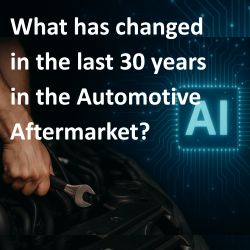
What Has Changed in the Last 30 Years in the Automotive Aftermarket? Categories: 2025, News Timelines: Argentina, Brazil, Central America, Chile, China, Colombia, France, Germany, India, Italy, Mexico, Morocco, Peru, Poland, Portugal, South Africa, Spain, Thailand, Turkey
Announcement Date : 27 May 2025
Over the past 30 years, the automotive aftermarket has experienced one of the most profound and continuous transformations in its history. From mechanical simplicity to digital complexity, from local service to global mobility, the changes have been both incremental and revolutionary.
But what exactly has changed? And what does it mean for the future of the sector?
Let’s start with the consumer. In 1995, the average European vehicle was younger, with a car parc age of 6.9 years. Fast forward to today, and drivers keep their vehicles significantly longer, with the average age now exceeding 11 years. This single shift has redefined the role of maintenance, extended the lifecycle of vehicles, and increased the demand for reliable and cost-effective service solutions.
At the same time, digitalization has reprogrammed the way drivers interact with the aftermarket. In the mid-90s, comparison shopping for repair services was almost unheard of. Today, 45% of European drivers go online to compare prices before booking. Expectations around transparency, convenience and speed have risen sharply and businesses that have adapted to this digital-first reality have earned a competitive edge.
Sustainability is another critical factor. In 1995, green credentials were not yet a driver of consumer behavior. Now, 60% of drivers consider sustainability and environmental impact when choosing a workshop, a trend that is only accelerating under regulatory pressure and cultural shift.
Meanwhile, under the hood, vehicles have transformed. The share of electronic components in modern vehicles has doubled compared to the 90s, making repairs more technical and increasingly reliant on diagnostics, software and specialized training. With 70% of new vehicles in Europe now connected, remote diagnostics and predictive maintenance are no longer emerging they are standard practice.
Distribution has also evolved. Once dominated by traditional brick-and-mortar networks, the rise of e-commerce has created a dynamic new sales channel. Online auto parts sales in Europe have exploded, growing from €5 billion in 2015 to over €20 billion in 2023. As platforms expand and logistics improve, the line between B2B and B2C continues to blur.
Throughout this evolution, GiPA has been present analyzing, measuring, and forecasting every key trend. With nearly 40 years of experience in primary research, market intelligence, and strategic insight, we’ve helped industry players make sense of change and prepare for what’s next. From the earliest signs of digital disruption to the current wave of electrification and sustainability, GiPA has served as a trusted partner in navigating complexity.
Today, the pace of transformation hasn’t slowed if anything, it’s accelerating. Electrification, AI-driven diagnostics, direct-to-consumer models, and changing vehicle ownership habits are redrawing the aftermarket map once again.
Understanding the past provides the real insight and It’s about seeing the trajectory clearly enough to anticipate the road ahead.
Want to understand where the aftermarket is going next?
GiPA is here to help you decode today’s data and shape tomorrow’s strategy.
GiPA© 2025













